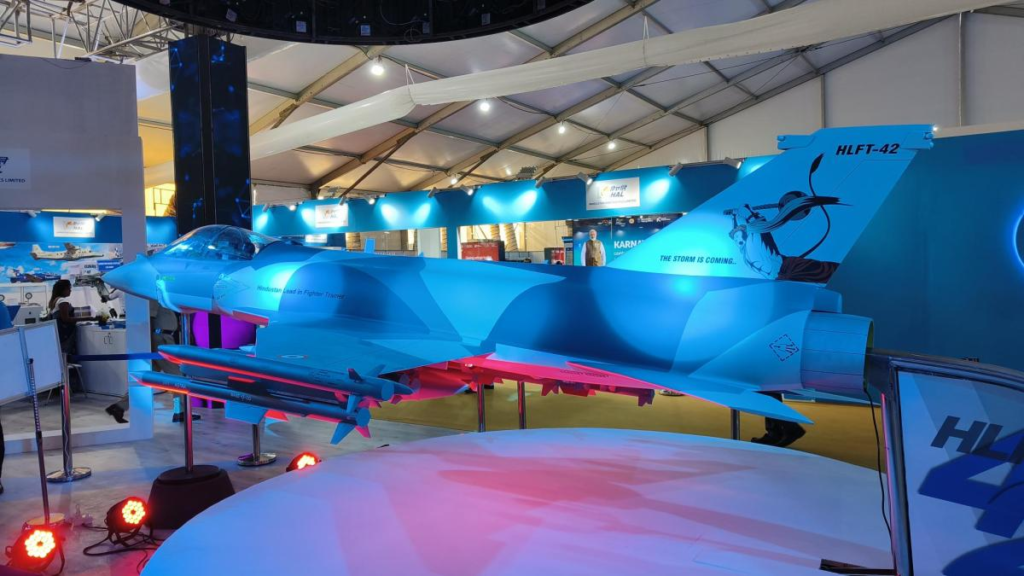Hindustan Aeronautics Limited (HAL) is actively searching for an advanced aero engine for its next-generation supersonic lead-in fighter trainer, the HLFT42. The company seeks a high-thrust, fuel-efficient, and reliable turbofan engine to power this cutting-edge training aircraft. This article explores the specifications of HAL’s requirements and potential vendors that can provide suitable engine solutions.

HLFT42: A Next-Generation Fighter Trainer
The HLFT42 is a twin-cockpit, supersonic, fly-by-wire aircraft designed to provide advanced jet training to student pilots. The aircraft must be capable of high-performance aerobatic maneuvers, ensuring effective training for future fighter pilots. It requires an engine with high thrust, reliability, and cost-effective maintenance, enabling four sorties per day over its total technical life.

HAL’s Engine Requirements for HLFT42
Performance Specifications
- Maximum Continuous Thrust: 21,350 – 22,500 lbf (95 – 100 kN) @ ISA SLS
- Specific Fuel Consumption (SFC): < 70g/s/kN
- Operational Endurance: 8 hours (preferable engine continuous run)
- Aerobatic Capability: Capable of sustained high-g maneuvers
- Time Between Overhaul (TBO): Minimum 2,000 flight hours
- Total Technical Life (TTL): More than 6,000 flight hours
- Maintenance: Low cost and minimal downtime
Aircraft Operating Envelope
- Maximum Speed: Mach 1.8
- Max Calibrated Airspeed: 1,400 km/h (750 knots)
- Min Calibrated Airspeed: Stable operation till 150 km/h (80 knots)
- Max Flight Altitude: 18 km (60,000 feet)
Engine Type
- Type: Turbofan with bypass & afterburner, FADEC controlled, self-contained lubrication system
- Thrust-to-Weight Ratio: Minimum 8:1
- Bleed Air Availability: Extraction required from both high-pressure (HP) and low-pressure (LP) compressor stages
- Fuel Type: Aviation kerosene IS 1571-2008 / Jet A-1 / JP-5 / JP-8
- Engine Control: Dual-channel FADEC with in-air relight capability
- Physical Dimensions:
- Max Length: 158 inches (4.0 meters)
- Max Diameter: 36 inches (0.9 meters)
- Max Dry Weight: 2,650 lbs (1,200 kg)
Potential Engine Vendors for HLFT42
Below is a comparison of potential engine vendors that offer systems similar to HAL’s requirements.
| Vendor | Engine Model | Thrust (kN) | SFC (g/s/kN) | TBO (hours) | TTL (hours) | Dimensions (LxD, meters) | Dry Weight (kg) |
|---|---|---|---|---|---|---|---|
| General Electric | F404-GE-IN20 | 85 kN | ~78 | 2,000 | 6,000 | 3.9 x 0.9 | 1,200 |
| General Electric | F414-GE-INS6 | 98 kN | ~70 | 2,000 | 6,000 | 3.9 x 0.9 | 1,200 |
| Safran | M88-4E | 75 kN | ~70 | 2,000 | 6,000 | 3.5 x 0.7 | 1,100 |
| Rolls-Royce | EJ200 | 90 kN | ~65 | 3,000 | 9,000 | 4.0 x 0.9 | 990 |
| Klimov | RD-33MK | 88 kN | ~79 | 2,000 | 4,000 | 4.2 x 1.0 | 1,150 |
Comparison: GE F414-GE-INS6 vs. Rolls-Royce EJ200
GE F414-GE-INS6
- Closely meets HAL’s thrust requirement (98 kN within 95-100 kN range).
- SFC is within HAL’s efficiency requirement (~70 g/s/kN).
- TBO of 2,000 hours aligns with HAL’s expectation.
- TTL of 6,000 hours meets HAL’s specifications.
- Dimensions (3.9m x 0.9m) fit within HAL’s constraints.
- Will be assembled in India by HAL, ensuring strategic and logistical advantages.
Rolls-Royce EJ200
- Slightly lower thrust (90 kN), though still viable.
- Superior SFC (~65 g/s/kN), making it more fuel-efficient.
- Longer TBO (3,000 hours) and TTL (9,000 hours), reducing maintenance frequency.
- Dimensions (4.0m x 0.9m) fit HAL’s constraints.
- Not currently planned for Indian assembly, potentially increasing acquisition costs.
| HAL’s Requirement | Specification | GE F414-GE-INS6 | Rolls-Royce EJ200 |
|---|---|---|---|
| Maximum Continuous Thrust (kN) | 95 – 100 | 98 | 90 |
| Specific Fuel Consumption (SFC) (g/s/kN) | < 70 | ~70 | ~65 |
| Time Between Overhaul (TBO) (hours) | Minimum 2,000 | 2,000 | 3,000 |
| Total Technical Life (TTL) (hours) | More than 6,000 | 6,000 | 9,000 |
| Maximum Length (meters) | 4.0 | 3.9 | 4.0 |
| Maximum Diameter (meters) | 0.9 | 0.9 | 0.9 |
| Maximum Dry Weight (kg) | 1,200 | 1,200 | 990 |
| Aerobatic Capability | Sustained high-g | Yes | Yes |
| Operational Endurance | 8 hours | Compatible | Compatible |
| Bleed Air Availability | HP & LP stages | Available | Available |
| Fuel Type | Jet A-1 / JP-5 / JP-8 | Jet A-1 / JP-5 / JP-8 | Jet A-1 / JP-5 / JP-8 |
| Engine Control | Dual FADEC | Dual FADEC | Dual FADEC |
| Thrust-to-Weight Ratio | Minimum 8:1 | ~8.1:1 | ~9.1:1 |
| Maintenance | Low cost, minimal downtime | Assembled in India, easier logistics | Lower lifecycle cost, longer TBO |
HAL’s search for an ideal aero engine for the HLFT42 is a crucial step in advancing India’s fighter training capabilities. The final choice will significantly impact the aircraft’s performance, operational efficiency, and long-term sustainability. By evaluating key vendors and engine solutions, HAL aims to equip the HLFT42 with a world-class propulsion system, ensuring optimal training for the next generation of fighter pilots.

I don’t understand what is the point of HLFT42 unless to be a low cost platform to mature Kaveri, which can be produced in hundreds, and offered to poor air forces. Otherwise no point competing with Tejas LIFT.
GE414 has better supply chain.
1) The HLFT-42 should be as large and heavy as the F-16
2) And due to which it would need a 28K-29K pounds thrust engine like the AL-31FP